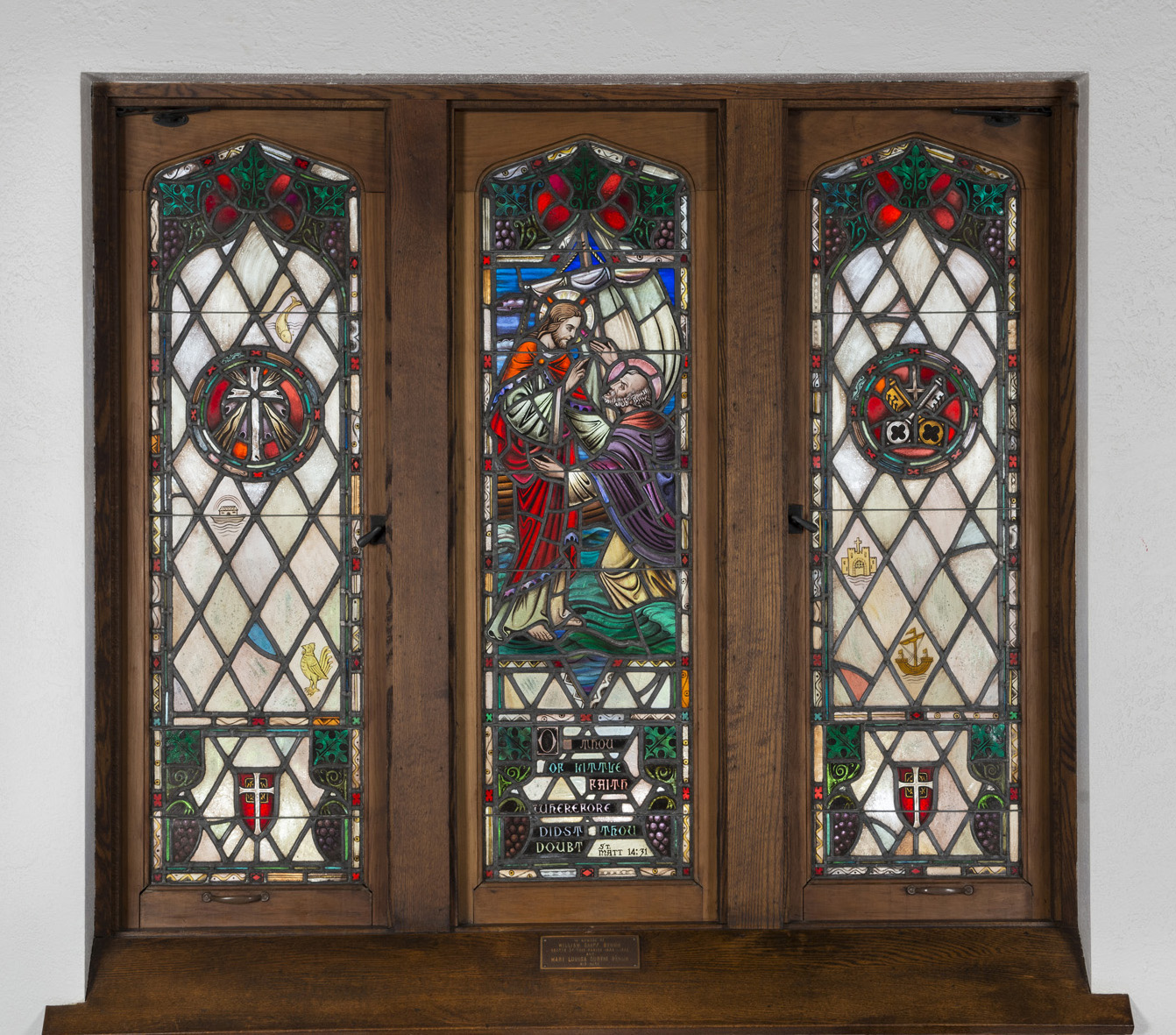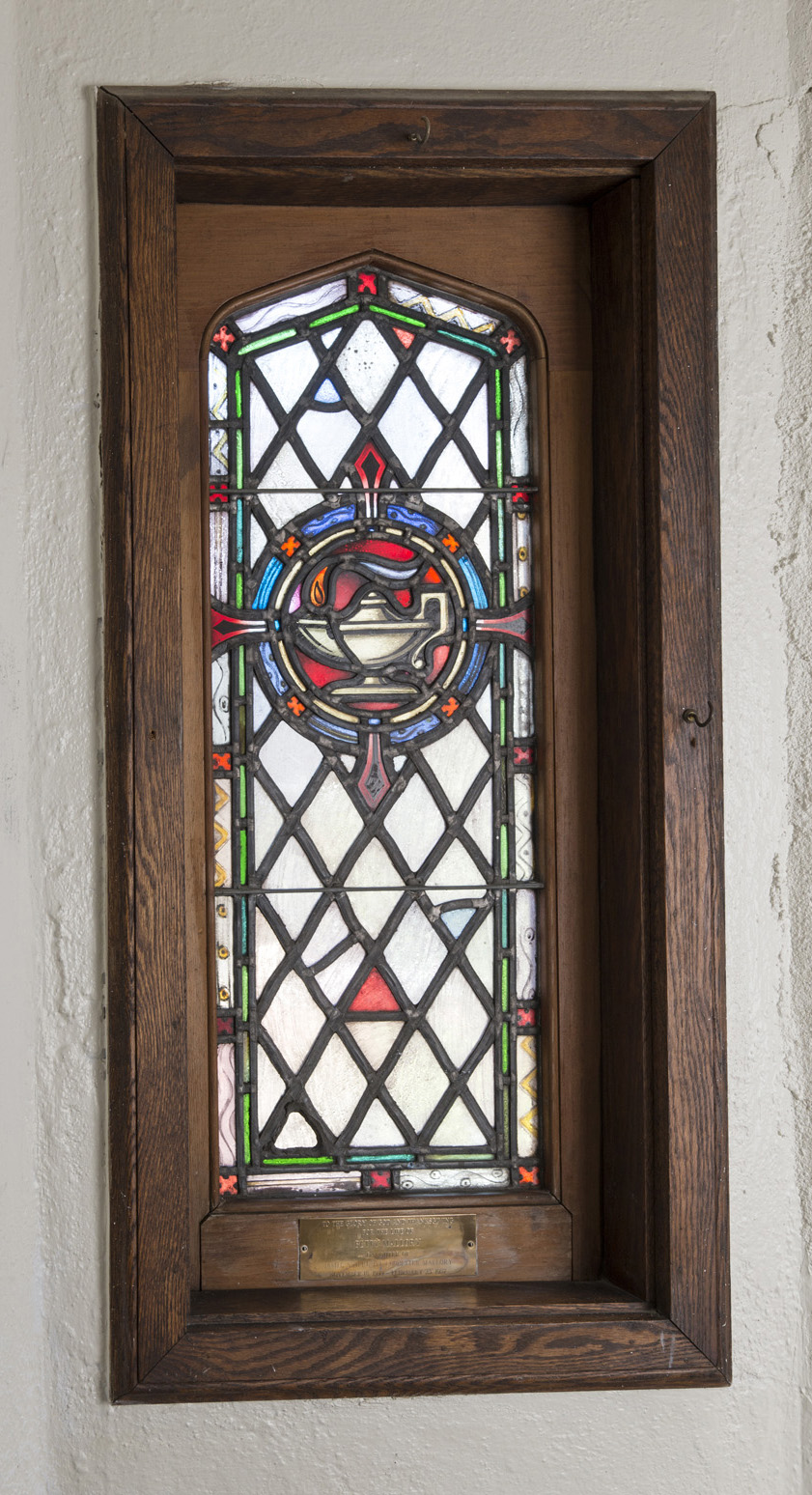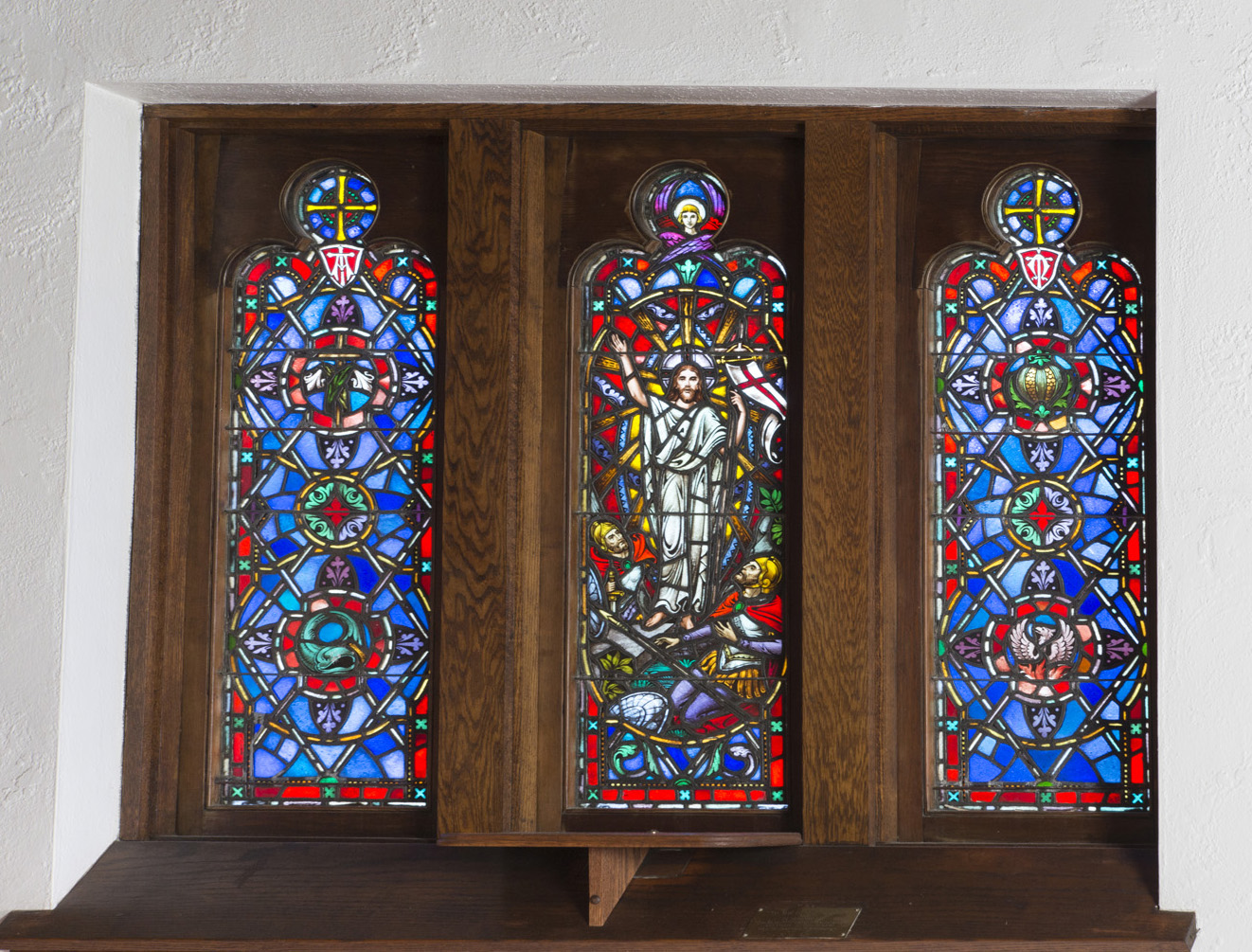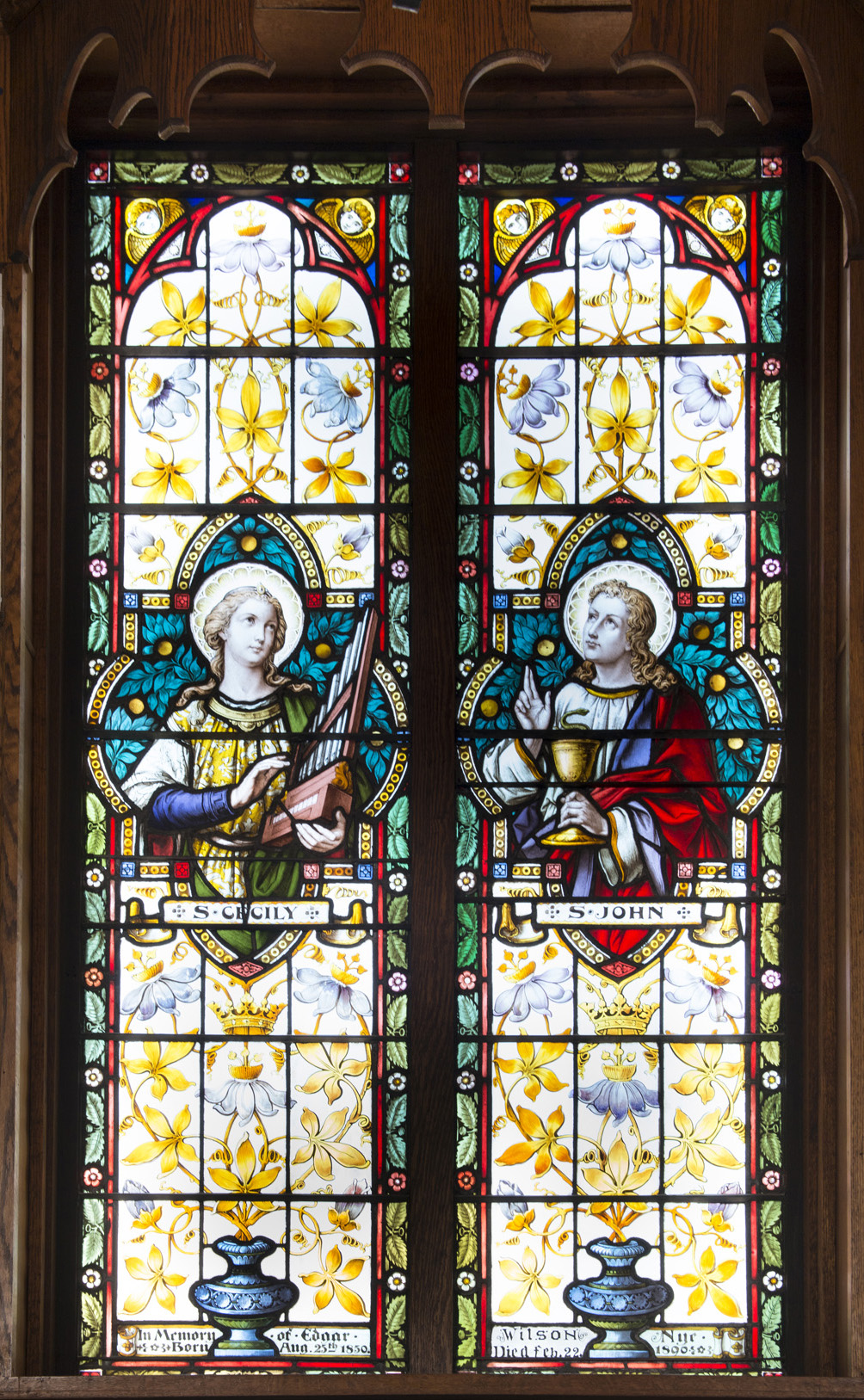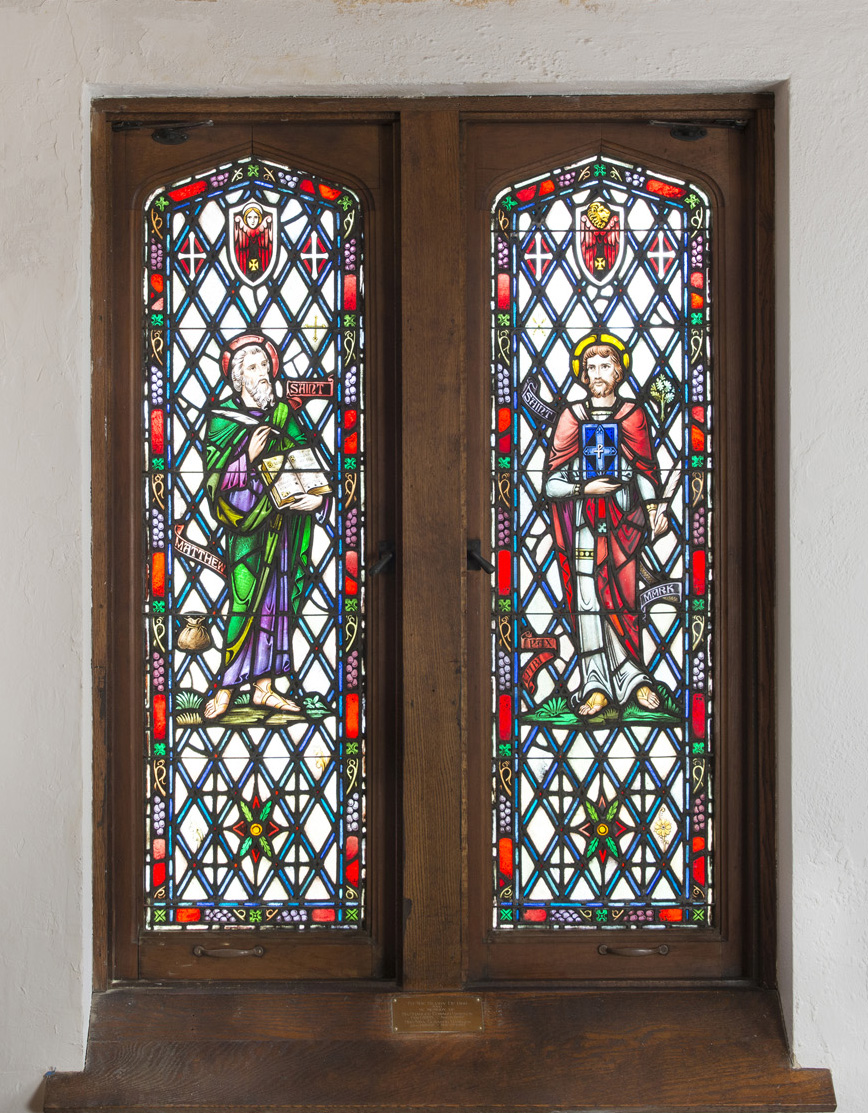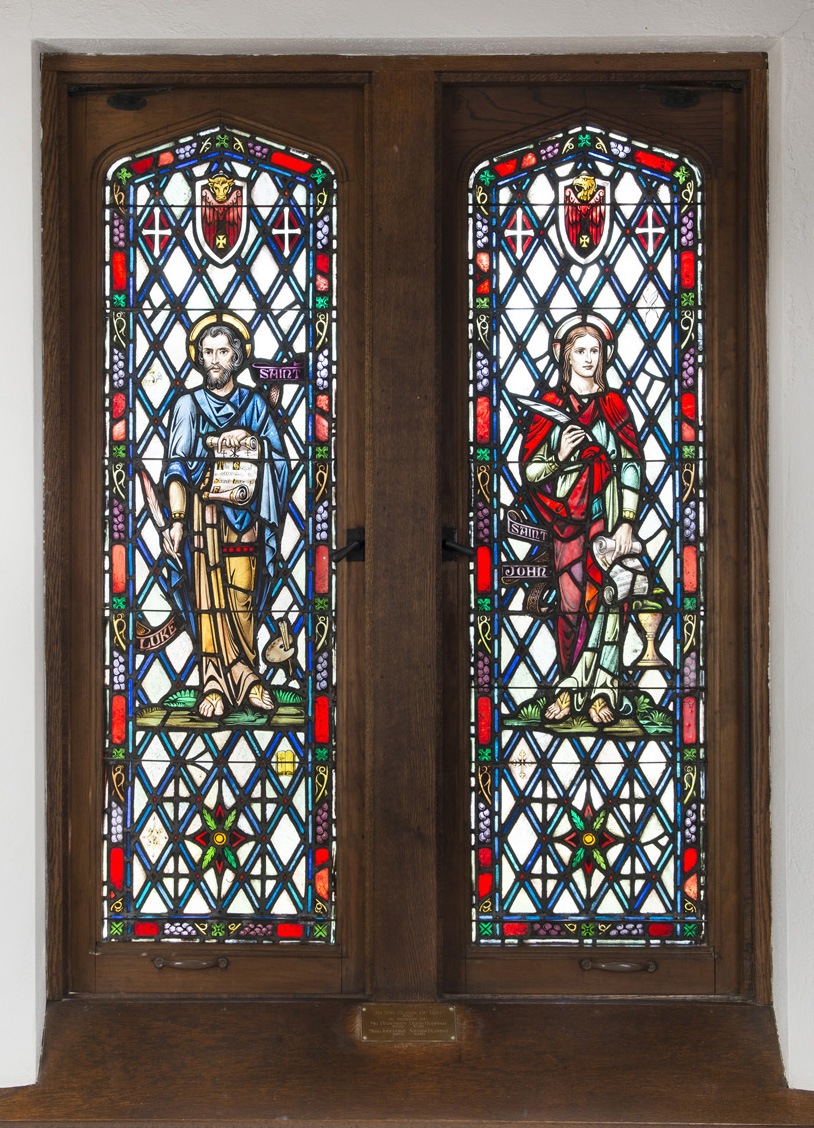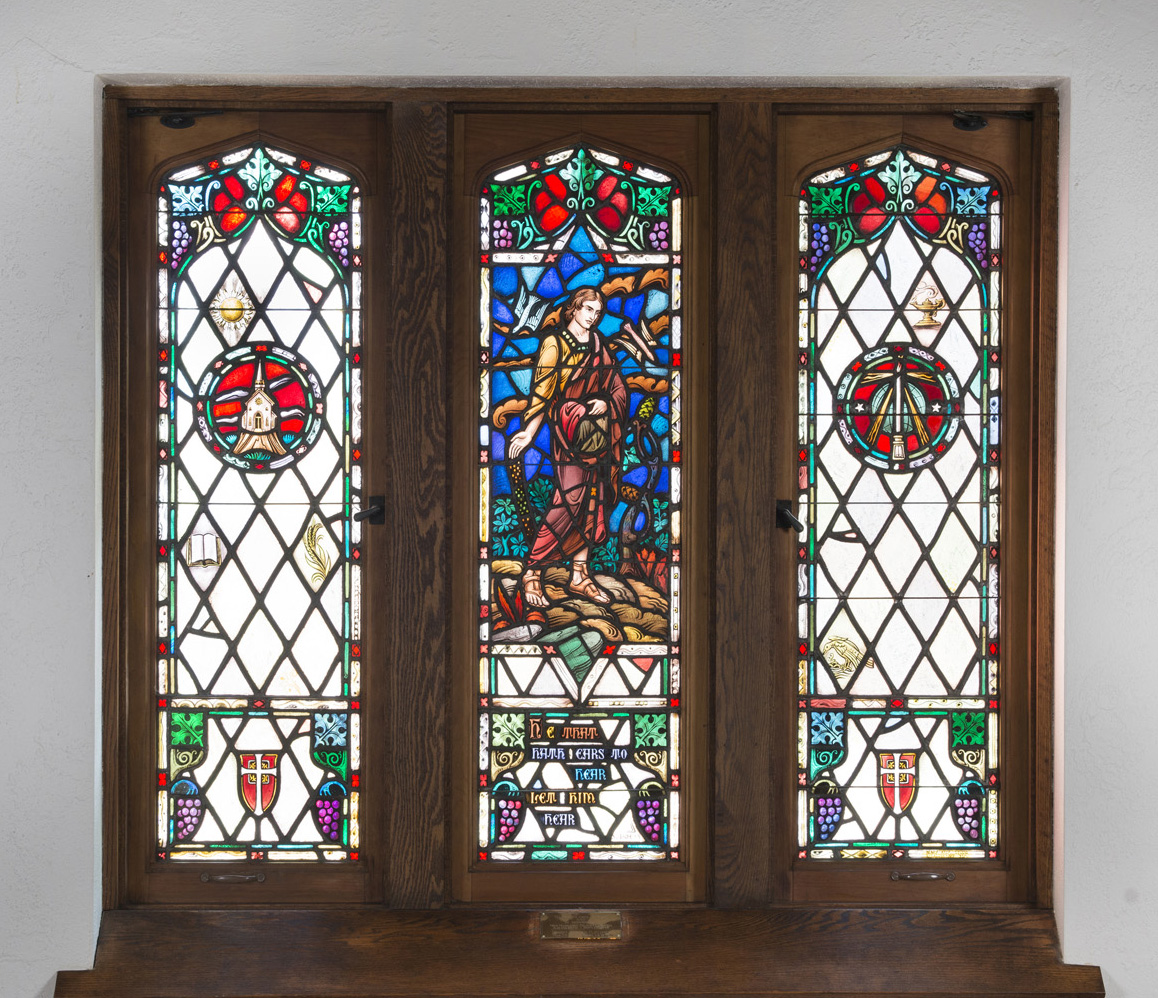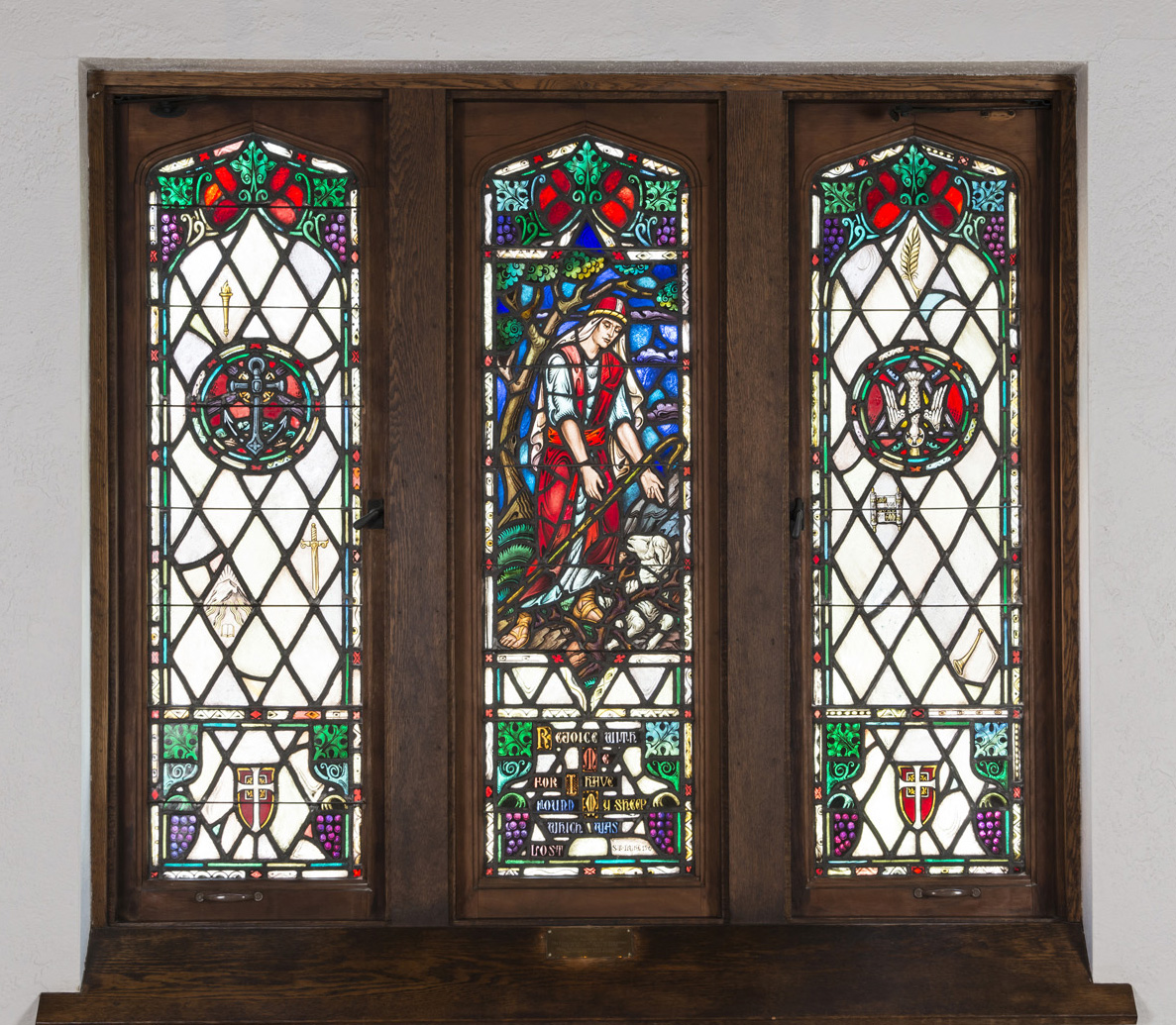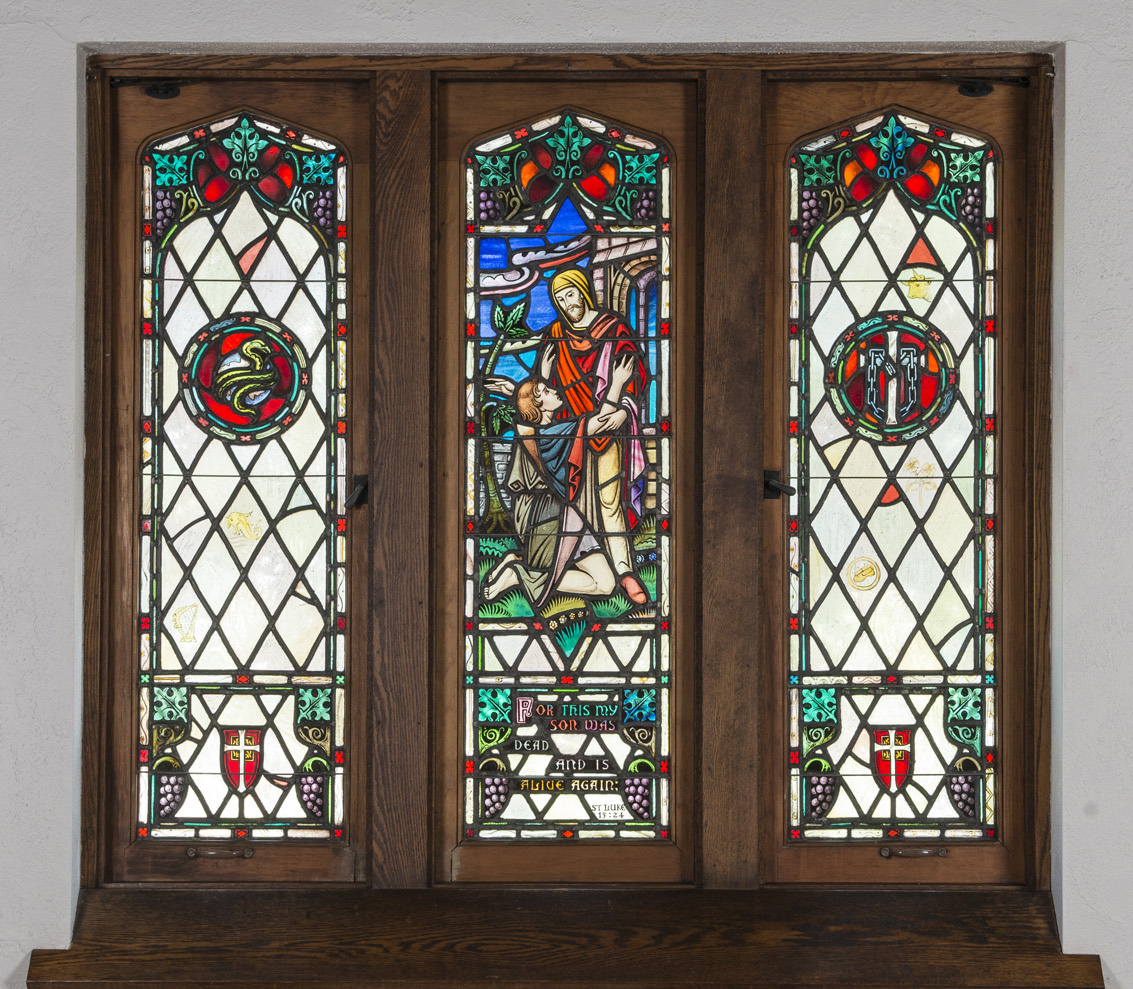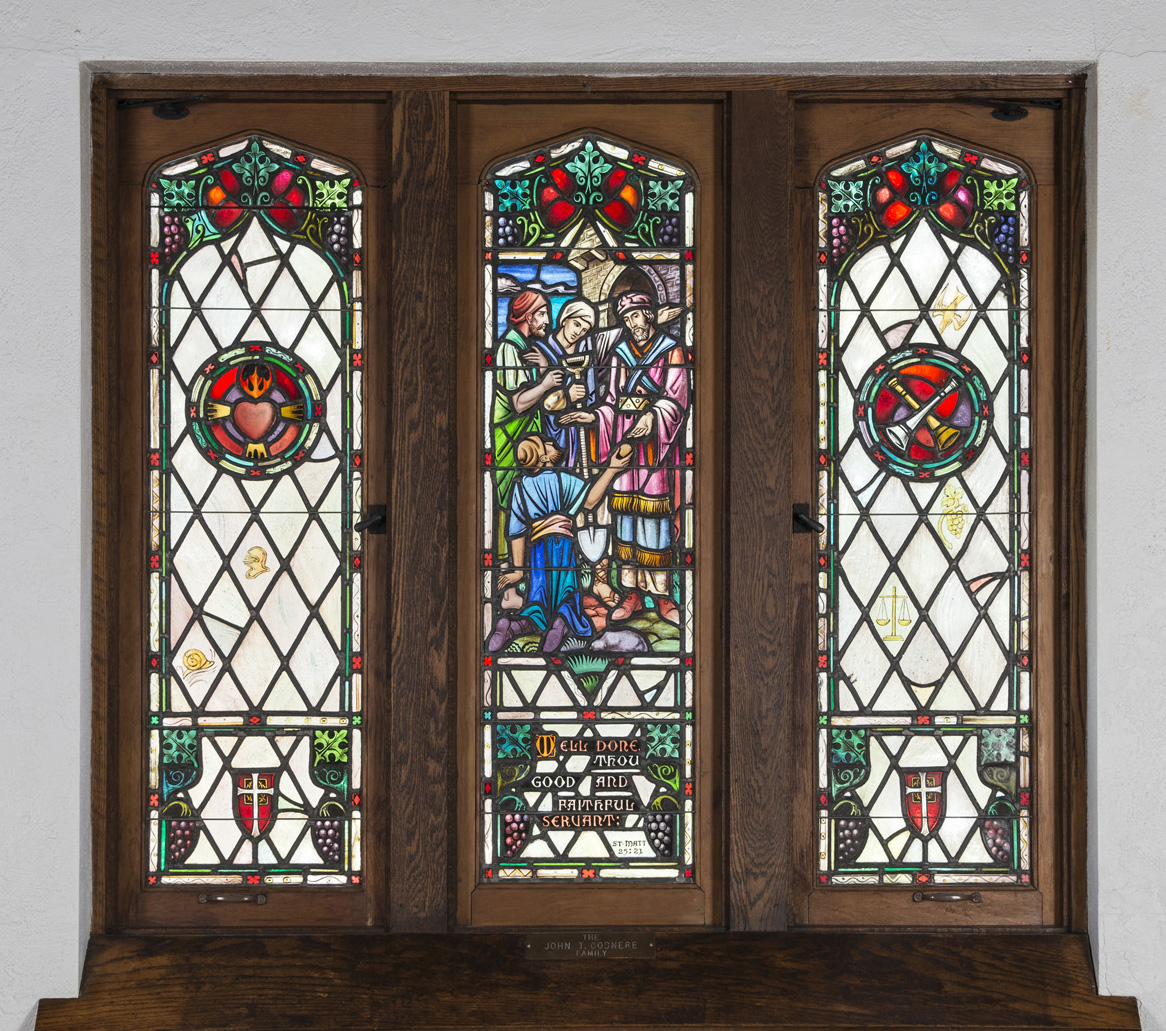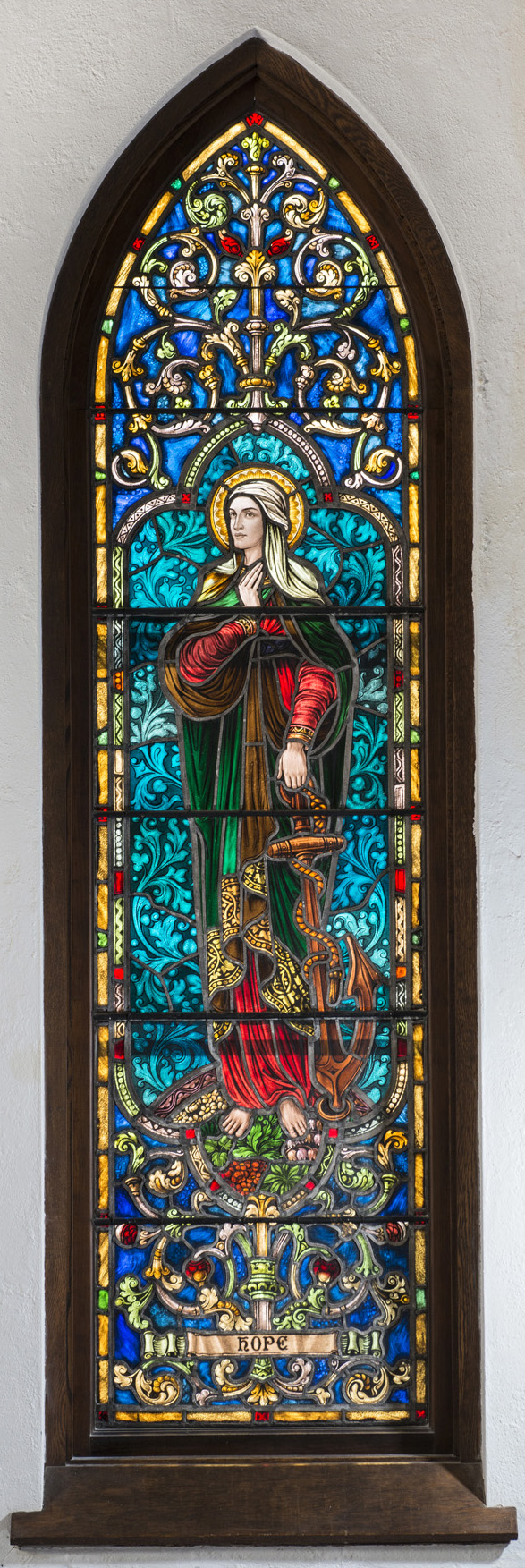The original purpose of stained glass was to teach the great truths of religion as well as to adorn the setting. Since most people could neither read nor write, the windows were used to explain the meaning of scripture through symbols.
The process of making stained or art glass by adding pigment to molten glass originated in the Near East in the ninth century and was widely adopted in Italy in the tenth century.
Stained glass windows have been placed in Calvary Episcopal Church since the original building was erected in 1859. A crucifixion triptych above the altar at the front of the church portrayed Jesus crucified in the central panel with the women in prayerful watch in the adjoining side panels. At the back of the church in the west wall near the entrance were the "Faith, Hope, and Charity" windows, stained glass much like the windows in the present church erected in 1938, only these are much enlarged. Only one window from the original structure survived the fire of December 22, 1935, the E.W. Nye Memorial window, which stands above the altar in the Founder's Chapel. It is believed this window was made in England by Heaton, Butkort, and Bane, a studio renowned for its English Victorian stained glass.
Of the twenty-three windows in this church (which is a modified Christopher Wren English Gothic design) most are Christ centered and in the thematic grouping. The theology which the art glass demonstrates is this: the glory, majesty, and love of God is made incarnate in Jesus by teaching and healing. They are all designed to be viewed and read from inside of the church. The south wall contains four panels on Jesus' parables. The north wall contains three panels demonstrating Jesus' miracles and the Nativity. The windows in the north and south walls are all framed with a pattern of vines and grapes. The central panel portrays the Biblical subject and citation. The flanking panels each have one major symbol reinforcing the panel's theme and many hand-painted symbols on the central theme, a Stanley Worden mark. At the bottom of each flanking panel is a red shield containing a cross and thorny crown. The four panels above the altar connect our Lord's "Agony in the Garden", His Crucifixion, His Resurrection, and His Ascension. The four panels in the south wall of the Founder's Chapel portray the four evangelists as they record the events of the life of the Savior. The west wall in the back of the sanctuary holds the "Faith, Hope, and Charity" set designed by the J & R Lamb Studios of Philmont, New York.
About the Artist
Seventeen of the windows in Calvary Church were designed by stained glass artist Stanley Elmore Worden (1922-1984), Chief Designer of the Henry Keck Stained Glass Studio, Syracuse, New York. The Keck Studio windows were installed between 1946-1966. Stanley Worden served in Keck's studio for fifty-two years. In 1974, his peers elected him for honorary life membership in the Stained Glass Association of America, one of only four artists to have been so honored.
No. 1 The Nativity
John 1:14 "And the word became flesh and dwelt among us."
The central panel presents the Holy Family. In the Middle Ages, the color blue (one of the first stains in glass) became symbolic for heaven and spiritual love. By the 16th century, it became customary to portray Mary wearing a blue robe. The Holy Family is seen beneath a blue evening sky with the star of the east, a sign of divine light and guidance, shining down on them. The regal purple of Joseph's robe indicates his importance. He holds a crook indicating he is father and protector of his family. Above the cow's head on the cow shed's post is an oil lamp, the ancient Jewish symbol for wisdom. Note that the baby Jesus' hand is raised in blessing.
The major symbol in the left panel is the Epiphany Star foretold by Jacob in Numbers 24:17. The painted symbols include the Cross and Orb (symbols of the Savior's triumph over the sin of the world), a lily (representing Mary's purity), and a rose (a symbol of the Nativity).
The major symbol in the right panel shows tongs holding a flaming coal, the symbol for Isaiah, the prophet who foretold the coming of the Messiah. The painted symbols are a serpent wrapped around the glove (sins spread over the earth) and the ancient monogram of the Virgin Mary.
Given to the Glory of God and in Loving Memory of
Edmund Muleneux Blake
Eleanor Brent Blake
No. 2 Christ Walking on Water
Matthew 14:31 "Oh thou of little faith, wherefore didst thou doubt?"
The central panel depicts Jesus walking on top of the blue waters extending his left arm to secure the sinking, doubting Apostle Peter, while with his right hand the miracle worker extends blessing. A ship's mast and sail are in the background.
A radiant cross is the primary symbol in the left panel, demonstrating the power of the cross to reach out and save. The painted figures include an ark on water with a rainbow (Noah's faith in God's word) and a great whale diving (Jonah's faith in God's deliverance). The cock is symbolic of Peter's denial (Matthew 26:69), a reference to Peter's doubt and fear.
Crossed keys are a symbol for peter. This major symbol in the right panel refers to Matthew 16:19, Christ giving the keys to the Kingdom of Heaven to Peter. The painted figures include a boat on water and a church standing on water. Jesus made Peter as well as all the other disciples and the Church "fisher's of men". It is the work of the Church to be faithful in the sea of life.
In Memory of
William Shipp Bynam, Rector of the Parish 1885-1889
Mary Louise Curtis Bynam, His Wife
No. 3 Raising the Widow's Son
Luke 7:14 "Young man, I say unto thee, arise."
The central panel shows three onlookers, the kneeling widow and Jesus touching the golden haired youth as he is restored to life.
An upright torch in a wreath signifies life, but when inverted as in the left panel, it means Death. The painted symbols include the words "God is Hove", a butterfly (symbol of resurrection), and a hear radiating love.
The major symbol in the right panel is an ornate crown symbolic of victory (over death in this instance). The painted symbols include a Ciborium (where the bread symbolic of Christ's resurrected body is reserved for the Eucharist) and the Greek letters for Alpha an Omega (Christ is referred to as "the beginning and the ending" in several scriptures, Alpha beginning the Greek alphabet and Omega the last letter). In this context the end of death brings the beginning of new life
To the Glory of God and in Loving Memory of
Mary Jane Corcoran
No. 4 Christ Casting Out the Demons
Mark 5:8 "Come out of the man, thou unclean spirit."
The central panel shows Jesus confronting the man with the unclean spirit who wields a club and has a broken shackle on his wrist. The mountains where the man lived are seen in the background and the ship that transported Jesus across the sea to the town of Gerasee is seen lower left. The two thousand swine now filled with the unclean spirits that Jesus has removed from the man are pictured running down a steep bank into the sea where they drowned.
The major symbol in the left panel is a scourge crossed with a flaming sword, a symbol of the Passion when Satan's power attempted victory over Jesus. Painted figures include a rose, a crown, and St. Michael the Archangel slaying a dragon (Satan).
A stag trampling a serpent is the major symbol in the right panel. The stag is traditionally a natural enemy of the serpent and represents Christ's power trampling over Satan. The painted symbols include another rose, and angel, and a cross radiating Christ's glory.
To the Glory of God and in Memory of
Mr. William H. Steward, Sr., December 21, 1871 - April 28, 1947
Mr. William H. Stewart, Jr., August 20, 1904 - February 9, 1944
No. 5 The Dorcas Window
Dorcas was a young early Christian disciple who lived in Joppa. She was well known for her works of charity. She died and the Apostle Peter raised her from the dead (Acts 9:36-43). This window is a memorial to women who died young also. Dorcas's name was Tabitha. Peter's words to raise her were, "Tabitha Cumi," similar to the words Jesus spoke when he raised the 12 year old daughter of Jairus, meaning "Young woman arise!" (Mark 5:41) The lamp is a traditional symbol for good works.
In Memory of
Betty Mallory
Daughter of James and Ruby Ledbetter Mallory, Nov. 18, 1949 - Feb. 23, 1957
No. 6 The Garden of Gethsemane
The windows to the left and right of the altar are another set of windows showing forth God's plan of salvation in the death, resurrection, and ascension of his son Jesus. There are more symbols in the windows of this set than others. A cherub is at the top of each center panel, flanked by a cross and a red shield containing a symbol. The cherub in the Gethsemane window is pale. The left and right panels each contain two major emblems as well as painted figures.
In the center panel Christ (shown with a red and gold nimbus) kneels in prayer. A large red-winged angel holding a cup, (the cup of suffering, red the color of suffering, Matthew 26:39 "Father, let this cup pass from Me." Just behind Jesus, three sleeping apostles are shown.
The red shield at the top of the left panel shows praying hands, a large rock (Hymnal 685 "The Rock of Ages"), and an incense pot, symbolic of prayer.
The red shield at the top of the right panel shows an anchor, symbolic of hope. The major emblem at the top is a lantern such as a soldier would have carried to the garden that night (John 18:3). The bottom emblem is an ear and sword referencing Peter's impulsive act in cutting off the ear of the High Priest's servant.
Memorial to
Mr. William H. Steward, Sr., December 21, 1871 - April 28, 1947
Mr. William H. Stewart, Jr., August 20, 1904 - February 9, 1944
No. 7 The Crucifixion
Jesus is shown nailed to a cross, the inscription posted above his head by the Roman soldiers as a joke reads "INRI," the Latin abbreviation for "Jesus of Nazareth, King of the Jews." Mary, his mother, and Mary Magdalene stand at the foot of the cross. A cherub with color is at the top of the panel.
The red shield at the top of the left panel is inscribed "HIS", the first three letters of the name "Jesus" in Greek. The two major emblems show a ladder crossed with a sponge on the end of a reed (Matthew 27:48) and dice with Jesus' robe, for which the soldiers cast lots.
The shield at the top of the right panel is inscribed P-X, the Chi Rho another symbol for "Christ" in Greek. The top emblem shows three large nails such as were used to nail him to the cross. The other emblem is the crown of thorns such as is shown on his head with the letters INRI inside the thorns.
Memorial to
Mary Jane Corcoran
Given by her Daughter and Grandchildren
No. 8 The Resurrection
A radiant Jesus, the Christ, rises from the tomb victoriously with banner unfurled. Two Roman guards are portrayed filled with fear, one dropping his spear. The marks from the nails show in Jesus' feet. The cherub is portrayed brightly. The red shields left and right are to be read as a unit. A cross unites with the Greek letter ___ the Alpha and another cross unites with the Greek letter ___ the Omega. "I am the beginning and the ending." The beginning of the Resurrection Life and the end to the power of death.
The emblems in the left window are a cluster of lilies (new life) and a yellow whale inscribed Matthew 12:40. "For as Jonah was three days and three nights in the whale's belly; so shall the Son of Man be three days and three night in the heart of the earth."
The pomegranate is the emblem at the top of the right panel. It has been called "The Tree of Life" from early Biblical times. A Phoenix rising out of ashes is the other emblem symbolic of resurrection and immortality.
Memorial to
William Shepp Bynam, Rector of this Parish 1885 - 1888
Mary Louisa Curtis Bynam, his wife
No. 9 The Ascension
In the central panel, eleven apostles look upward as Christ ascends into heaven, the imprint of his pierced feet visible on the ground. In the Resurrection window, Jesus' eyes are open; here they are closed. Yet another cherub is above his head.
The shield in the left panel shows a soaring winged eagle. The emblems are Christ's footprint in the earth and an ascending fiery chariot such as carried Elijah to heaven. The shield in the right panel is a Roman eagle on a staff symbolic of Christ's power over civil authority. His lordship over all things is portrayed in an orb, the symbol of a monarch. The Gate of Paradise is radiant, awaiting the entrance of "The King of Kings." Life, Death Resurrection, and Ascension, the Ascension completes and closes the work of Jesus Christ on earth.
Memorial to
Edmond Molyneux Blake, Colonial United States Army 1866-1927
Eleanor Brent Blake, 1868-1961
No. 10 The Eucharist
This small window in the hallway leading from the Chancel to the Founder's Chapel bears the traditional symbol for the Eucharist, a gold chalice with a white wafer bearing IHS, the first three letters of the Greek spelling of Jesus I H < O U S. There is a large nimbus with tall points of gold and shorter points of silver. The window is strategically located between Calvary's two altars for the Eucharist known as "the sacrament of the altar."
No. 11 The Nye Memorial Window
This is the only existing window from the original church building of 1859. It was literally ripped from its hinges during the fire of 1935 that destroyed all of Calvary Church, save the belltower which stands to this day. The window is of the English Vicorian style and is thought to be a Heaton, Butkort, and Bane brought here from England.
The window consists of two panels depicting "S*Cecily" and "S*John", both early martyrs of the church. The left panel shows St. Cecily or St. Cecelia, the patron saint of church musicians. Legend tells of her hearing the singing of angels in her head leading her to invent the organ. She is shown holding a hand organ while looking to the heavens. She is wearing a gold mantle with the same fleur-de-lis design that is in the window's background. The right panel shows a very feminine-looking St. John, the Gospel writer. (This is a mark of the English Victorian style). He is holding a chalice containing a serpent, a reference to his First Epistle (I John 1:7) "Christ's blood purging Adam's Original Sin." He is wearing a mantle of crimson representing sacrificial blood. The right hand gives forth a blessing.
At the base of each window there is a vase holding fleur-de-lis (another mark of English Victorian style) which rise heavenwards to the top of each panel where two cherubs look down upon each martyr. Across the bottom is the dedication, "In Memory of Edgar Wilson Nye, born August 25, 1850, died February 26, 1890."
Nos. 12, 13, 14, 15 The Four Evangelist
This set of windows in the south wall of the Founder's Memorial Chapel is a treasure, rich in teaching.
All four Gospelers are presented holding a quill writing instrument and a manuscript of his gospel. A nimbus or gold halo is over the head of each, marking the person as a "Holy" figure.
At the bottom of each panel there is a set of four crosses representing the four accounts of the ministry of Jesus, the Christ of God.
No. 12 St. Matthew
Matthew is presented as a distinguished elder with a grey beard and hair dressed in a green robe. His book is open to his account of the Sermon-on-the-Mount and shows two of Jesus' Beatitudes: "Blessed are the poor is spirit for theirs is the Kingdom of Heaven," "Blessed are those who mourn for they shall be comforted." (Matthew 5: 3-11) There is one distinct symbol in each window that focuses on the person shown. For Matthew it is a moneybag since he was a tax collector before becoming a follower of Christ. Above Matthew's image is his Christian symbol set in a shield between matching crosses. Matthew's symbol is that of a winged man because his gospel emphasizes the human nature of Christ.
No. 13 St. Mark
Mark is presented as a younger man with bright red hair and beard wearing a red mantle. He holds a beautifully bound blue manuscript, which is quite ornate. His distinct symbol is the Latin inscription PAX TIBI meaning "Peace be with you," a greeting Jesus uses frequently in Mark's gospel. Above Mark's image is his Christian symbol set in a shield between matching crosses. Mark's symbol is a winged lion because his gospel stresses the kingship of Christ.
Memorial to
Mr. Charles E. Dameron
Mrs. Nita C. Dameron
No. 14 St. Luke
Luke is presented with brown hair and beard, dressed in a fine robe of gold color with a blue mantle. He is holding a scroll on which is written "The Gospel According to St. Luke." His symbol is an artist pallet and brushes signifying scholars belief that he is the most artistic writer among the four gospels. Above Luke's image is his Christian symbol set in a shield between matching crosses. Luke's symbol is a winged ox (or calf) showing the priestly nature of our Lord's ministry emphasized in his gospel.
No. 15 St. John
John is presented as the most youthful of the Gospel writers, having no beard, but a smooth face. He is wearing a bright red mantle and holding a scroll noting the beginning of his gospel, "In the beginning was the Word" (John 1:1). His symbol is a chalice with a serpent emerging, the same symbol found in the Nye window over the chapel altar. (See Nye Window No. 10 for explanation). Above John's image is his Christian symbol set in a shield between matching crosses. John's symbol is a winged eagle. It represents his emphasis on the divine nature of Jesus. His message soars heavenward as on an eagle's wings. The Word of God at Calvary Church is proclaimed from a lectern that is a carved large-winged eagle.
Memorial to
Mr. Chauncey A. Cushing
Mrs. Josephine A. Cushing
No. 16 The Baptismal Window
The baptismal font stood in this Baptistery area until 1984 when it was moved into the center of the church for liturgical customs that have become the present norm in the Episcopal Church.
A descending dove representing the activity of the Holy Spirit is at the top of each panel. The theme of this set is "He shall baptize you in the Holy Spirit and in fire." The left panel shows a young Jesus standing in the waters of the Jordan River, head bowed, while the rugged wilderness prophet John pours water from a scallop shell over Jesus' head. John the Baptist is shown with his emblem, a long reed in hand. At this point Jesus is identified by the Spirit as God's own. "This is my beloved Son, in whom I am well pleased." The right panel depicts the Baptism of the Holy Spirit on the Day of Pentecost. Seven flames representing the seven gifts of the Holy Spirit descent six disciples, three shown with nimbus about their heads (To the right of the panel), and three without a nimbus (to the left side) including one woman veiled in blue.
No. 17 The Parable of the Sower
Luke 8:8 "He that hath ears to hear, let him hear."
The central panel shows a handsome young sower scattering varying colors of seed upon various colors of soil while birds dart towards the ground to snatch the seed away. The variety of seeds and soil conditions represent the nature of the kingdom of God.
The panel on the left shows a church upon a mountaintop with radiating sunlight as the emblem. This might well be Calvary Church set atop a high hill in Fletcher, but more likely symbolizes the church founded on a rock-solid foundation, Jesus the Christ. The painted symbols include a sunburst (sun is essential to seed growth), a grain of wheat and the pistol of a flower, the yield of the seed and an open Bible, signifying God's holy word. "He that hath ears to hear, let him hear."
A radiant candle dominates the right panel representing Jesus Christ the Light of the World. An open book at the candle base is symbolic of enlightenment (a reinforcement of Luke 8:8). Among the painted symbols there is an oil lamp symbolic of the word of God ("Thy Word is a lamp unto my feet"), a bird plucking the seed away, and a yellow vine.
The left panel is marked "Keck Studio-1959.
To the Glory of God and in memory of
Mrs. Margaret Beale Fletcher, August 29, 1878-September 28, 1948
Robert Walker Fletcher, March 25, 1876-September 24, 1970
No. 18 The Parable of the Lost Sheep
Luke 15:6 "Rejoice with me for I have found my sheep which was lost."
The central panel shows a prosperously dressed shepherd dropping his shepherd's staff to rescue this beloved sheep entangled in snares.
The anchor, a symbol of hope is the emblem dominating the left panel. The painted symbols include a torch lanthrem, a sword representing valor and a mountain with light streaming down towards an open book. This is probably signifying God's glory shown forth on Mt. Sinai resulting in the Book of the Law of Moses.
The major symbol in the right panel depicts a descending dove symbolic of the activity of the Holy Spirit of God. The painted symbols include the Palm Branch of Spiritual victory, a trumpet heralding the arrival of the Savior, and a scroll inscribed "Love the Lord thy God."
In Memory
Mr. Benjamin Lafayette Shuford, August 8, 1877-September 4, 1949
Mrs. Meta Christine Shuford, May 12, 1878-February 1, 1942
No. 19 The Prodigal Son and Loving Father
Luke 15:24 "For this my son was dead and is alive again."
The central panel shows the son kneeling barefooted before his richly clothed and sandaled father, both with arms outstretched.
This left panel's symbol shows a large serpent encircling the globe representing the Fall of Man and the Spread of Sin. The small ornate yellow fish remind us of Jonah who emerged from the belly of the whale to new life. The harp, symbolic of joy, echoes the remainder of the verse quoted, "and they began to make merry."
The right panel shows a cross wrapped with a broken chain symbolic of Christ's breaking the bonds of sin and death through His death and resurrection. The dogwood branch reminds us of the cross of Christ and new life that comes with resurrection. There is the head of the fatted calf, slaughtered in celebration of the son's return (Luke 15:23) and the gold ring encircling the new shoes his father gave him (Luke 15:22).
In Memory
Howard Orr Hayes, 1889-1956
No. 20 The Parable of the Talents
The first window on the South side of the Nave nearest the Narthex entrance depicts Jesus' Parable of the Talents.
Matthew 25:21 "Well done, thou good and faithful servant."
The central panel portrays the Master of the House finely dressed with a gold belt, gold fringes on this tunic, and wearing shoes meeting the servant who hid his talent (or gold coin) in the ground for safe-keeping. The servant is kneeling, offering the talent to the outstretched hands of the owner. Two other servants witness the recovery, one holding the shovel used to unearth the talent and the other holding a bag of coins. The scriptural reference is at the bottom of the panel
The dominant symbol in the panel to the left is a heart surmounted with a flame and radiating golden rays, symbolic of intense zeal or devotion. The painted symbols include the Helmet of Salvation and a snail (The wicked and slothful servant...Matthew 25:26).
Crossed trumpets, one gold and one silver, dominate the right panel, symbolizing an announcement. The painted symbols include a dove, symbolic of humility; the Balances of Justice; and grape, symbolic of the fruits of one's labors.
A Gift of the John T. Codnere Family
No. 21, No. 21A, No. 21B The Faith, Hope, and Charity Set
This "Triptych" of windows in the West wall to the left of the Narthex entrance is the largest in Calvary Church. Designed by the J. and R. Lamb Studio of Philmont, NY. They show another style of stained glass art. Installed with the new church in the late 1930's, these windows illustrate some of the changes made from medieval to modern stained glass: softer colors, larger pieces of glass, and more definition of the background scene.
The "Faith" panel has a large Celtic Cross at the center of a floral garden with an effeminate looking male figure wearing shoes, his arms raised upward in blessing. This is probably Jesus Christ, the object and center of our faith. The names "Price", "Westfeldt", and "Reynolds" appear below the word "Faith." These are the three related families who were the donors of this triptych.
"Charity" is portrayed by a lovely woman whose head is covered and show is not wearing shoes. She has in her hands a water pitcher and a goblet generously offering a drink to all who thirst.
"Hope" is portrayed as another lovely woman; head covered, no shoes, standing beside a large anchor, the church's traditional symbol of hope.
Original Contributors to the Calvary Stained Glass Window Project:
David Sailer, Rector 1984-1998
Barbara L. Smith
David Kiser
Tom and Brenda Nash
William C. Swann
Paige Smith Few
Nyla Sailer
Suzanne Nesbitt Dawkins



